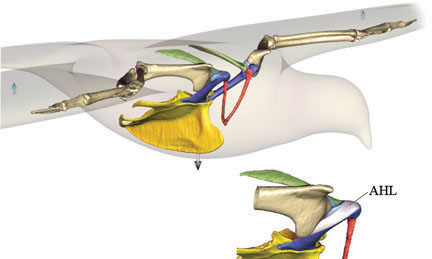
A press release from Brown University describes the evolution of structures required for flight. Turns out that a specific ligament (labeled “AHL” in the above image) provides stabilization to maintain a gliding posture in pigeons—computer modeling permitted the calculation of the necessary forces and also resulted in a pretty spiffy image to illustrate the findings. It actually took me a moment to see the symmetry in the image, but as soon as I “read” the pigeon’s beak pointing to the right, it snapped into place. Nice work.
The caption for the above reads, entertainingly enough, “Using computer modeling, treadmills and the fossil record, researchers have shown that the acrocoracohumeral ligament (AHL), a short band of tissue that connects the humerus to the shoulder joint in birds, was a critical element in the evolution of flight.” The treadmills, BTW, came into play when alligators (close but obviously flightless relatives of the birds) were x-rayed while walking; researchers found that muscles, not ligaments, supported the shoulder. The fossil record seems to indicate that the ligament structures evolved gradually.
Also, it’s worth noting that the image is credited to the researcher himself, David Baier, who seems to have recently gotten his Ph.D. It’s great to see imagery coming directly from the person doing the work. The Brown University Ecology & Evolutionary Biology Newsletter from May 2004 describes some related work and makes mention of Baier.
